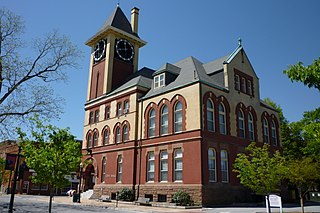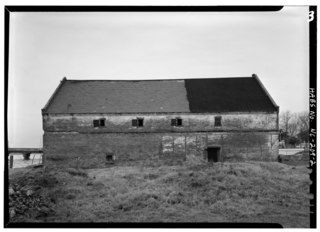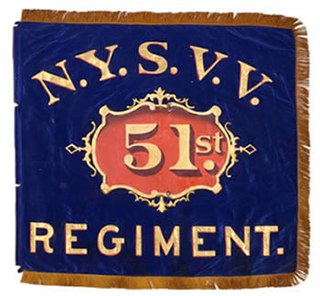
Newport is a town in Carteret County, North Carolina, United States. The population was 4,510 at the 2010 census.

New Bern, formerly called Newbern, is a city in Craven County, North Carolina, United States. As of the 2010 census it had a population of 29,524, which had risen to 31,291 people as of the 2020 census.

Hampton Roads is the name of both a body of water in the United States that serves as a wide channel for the James, Nansemond and Elizabeth rivers between Old Point Comfort and Sewell's Point where the Chesapeake Bay flows into the Atlantic Ocean, and the surrounding metropolitan region located in the southeastern Virginia and northeastern North Carolina portions of the Tidewater Region.

The Virginia Peninsula is a peninsula in southeast Virginia, bounded by the York River, James River, Hampton Roads and Chesapeake Bay. It is sometimes known as the Lower Peninsula to distinguish it from two other peninsulas to the north, the Middle Peninsula and the Northern Neck.

The Battle of New Bern was fought on March 14, 1862, near the city of New Bern, North Carolina, as part of the Burnside Expedition of the American Civil War. The US Army's Coast Division, led by Brigadier General Ambrose Burnside and accompanied by armed vessels from the North Atlantic Blockading Squadron, were opposed by an undermanned and badly trained Confederate force of North Carolina soldiers and militia led by Brigadier General Lawrence O'B. Branch. Although the defenders fought behind breastworks that had been set up before the battle, their line had a weak spot in its center that was exploited by the attacking Federal soldiers. When the center of the line was penetrated, many of the militia broke, forcing a general retreat of the entire Confederate force. General Branch was unable to regain control of his troops until they had retreated to Kinston, more than 30 miles away. New Bern came under Federal control, and remained so for the rest of the war.

The Battle of Washington took place from March 30 to April 19, 1863, in Beaufort County, North Carolina, as part of Confederate Lt. Gen. James Longstreet's Tidewater operations during the American Civil War. This battle is sometimes referred to as the siege of Little Washington.

The Carolinas campaign, also known as the campaign of the Carolinas, was the final campaign conducted by the Union Army against the Confederate Army in the Western Theater of the American Civil War. On January 1, Union Maj. Gen. William T. Sherman advanced north from Savannah, Georgia, through the Carolinas, with the intention of linking up with Union forces in Virginia. The campaign culminated in the defeat of Confederate Gen. Joseph E. Johnston's army at the Battle of Bentonville, and its unconditional surrender to Union forces on April 26, 1865. Coming just two weeks after the defeat of Robert E. Lee's army at the Battle of Appomattox Court House, it signaled that the war was effectively over.

Henry Marchmore Shaw was a Congressional Representative from North Carolina, as well as an officer in the Confederate States Army during the American Civil War. He was killed in action, one of a handful of former U.S. Congressmen to perish during the conflict.
The 9th New Jersey Infantry Regiment was an American Civil War infantry regiment from New Jersey that served from October 1861 through July 1865 in the Union Army. The regiment got its nickname, Jersey Muskrats, during the Battle of Roanoke Island when they successfully "sloshed through shoe sucking mud into waist deep water in "division" formation", giving the regiment a two-company front flanking the enemy. The regiment was the last to leave the state in 1861 but the first to see battle.

The city of Winchester, Virginia, and the surrounding area, were the site of numerous battles during the American Civil War, as contending armies strove to control the lower Shenandoah Valley. Winchester changed hands more often than any other Confederate city.
The Department of Virginia and North Carolina was a United States Military department encompassing Union-occupied territory in the Confederate States during the Civil War. In 1863 it was formed by the merging of two previously existing departments: the Department of Virginia and the Department of North Carolina. In 1865 the two departments were once again separated.
Burnside's North Carolina Expedition was a series of engagements fought along the North Carolina Coast between February and June 1862. The expedition was part of Winfield Scott's overall Anaconda Plan, which aimed at closing blockade-running ports inside the Outer Banks. The amphibious operation was carried out primarily by New England and North Carolina troops under Brig. Gen. Ambrose E. Burnside and assisted by the North Atlantic Blockading Squadron under Captain Louis M. Goldsborough.

Fort Harney was a United States Army outpost in eastern Oregon in the United States. It was named in honor of Brigadier General William S. Harney. Fort Harney was used as a supply depot and administrative headquarters from 1867 to 1880 during the Army's campaign against Northern Paiute bands in Eastern Oregon and the Bannock uprising in the same area. Today, nothing remains of Fort Harney except a small cemetery.

Theodore Safford Peck was an American Civil War veteran who received the Medal of Honor. He also attained the rank of major general as Adjutant General of the Vermont National Guard.

Stoneman's raid in 1865, also called Stoneman's last raid, was a military campaign in the Upper South during the American Civil War, by Union cavalry troops led by General George Stoneman, in the region of eastern Tennessee, western North Carolina and southwestern Virginia.

The Battle of New Bern was fought during the American Civil War from February 1–3, 1864. The battle resulted in the failure of Confederate forces trying to recapture the coastal town of New Bern which had been lost to the Union Army in 1862.
The 132nd New York Infantry Regiment, the "Second Regiment, Spinola's Empire Brigade"; or "Hillhouse Light Infantry", was an infantry regiment of the Union Army during the American Civil War.

The 17th Massachusetts was an infantry regiment that served in the Union Army during the American Civil War.
The 25th Regiment Massachusetts Volunteer Infantry was an infantry regiment that served in the Union Army during the American Civil War.

The 51st New York Infantry Regiment was an infantry regiment in the Union Army during the American Civil War.













